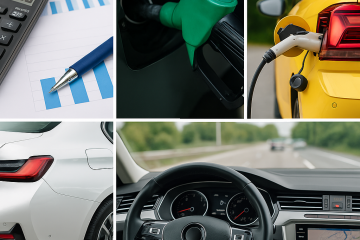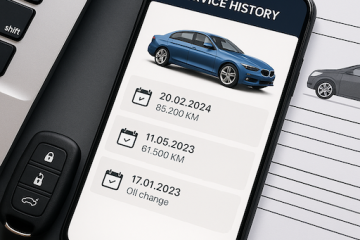Market Insight: Balancing the Used EV Surge

One Auto API CEO Mark Fretwell examines the impact of the growing influx of used electric vehicles (EVs) set to enter the market and highlights why, now more than ever, a data-driven approach is essential for navigating this evolving landscape.
Recently, I had the opportunity to attend an EV Ride & Drive Event hosted by the Vehicle Remarketing Association (VRA) at Arval’s UK headquarters in Swindon. The event showcased models from BYD, Hyundai, and others, as well as a selection of used vehicles.
One of the stand-out experiences was driving a three-year-old, 400bhp Polestar 2 with 25,000 miles. It may have been a bit small for my personal needs, but the Polestar was a fantastic car to drive and retailing at around £25,000, it struck me as offering exceptional value for the performance and quality.
It’s no surprise, then, that vehicles like this are in high demand at auctions, regularly selling with slim retail margins – often just a few hundred pounds – because of how quickly they move from the forecourt.
Recent data from Auto Trader supports this trend, showing that the used EV market has seen demand increase by 50% year-on-year, with vehicles selling in an average of 26 days, and prices beginning to stabilise.
However, despite falling EV prices, consumer hesitation remains a critical challenge for widespread EV adoption.
New research from JudgeService suggests that many buyers, particularly those in older demographics, are still uncertain about EVs, concerned about charging infrastructure, range anxiety, and the overall reliability of the technology.
This reluctance is shaping the market in ways that go beyond just pricing. Education and clear communication will be essential in overcoming these barriers.
The Challenge Ahead: Balancing Supply and Demand
And as fleets dispose of increasing volumes of used EVs into the market, the potential for oversupply looms large on the horizon.
Currently, the sweet spot for used EVs would appear to lie in vehicles that are three to five years old. However, according to Auto Trader’s Road to 2035 report, while there were 85,000 such EVs on UK roads by the end of 2023, this figure is expected to surge to 606,000 by 2025 – an almost tenfold increase in just a few years.
There is a genuine risk that this increase in supply will not be matched by increases in demand, which could disrupt the current stability and heap pressure on used EV prices.
Could the upcoming Autumn Budget offer relief?
As we look towards the upcoming Autumn Budget, many in the industry are hopeful that new measures will help boost EV demand to match the anticipated supply increase.
Potential incentives, such as improvements to public charging infrastructure, expanded tax benefits, or adjustments to fuel duty, could start to spark consumer interest and start to shape how both new and used EV markets evolve in the coming years.
However, we can’t rely on government policy alone to stimulate demand.
Education at Every Stage of the EV Lifecycle
As noted earlier, education remains one of the most crucial factors in ensuring a successful transition to electric vehicles.
This education must span the entire lifecycle of the EV – from the moment a customer considers purchasing a new EV to its reintroduction into the used car market.
For new EVs, education starts with manufacturers, fleet providers, and dealerships. They must address the concerns of first-time buyers and drivers who may still be unsure about issues like range, battery longevity, and charging practicality.
A great example of how education can make a difference is the EV range tool available on the Fleet News website. Powered by One Auto API, this tool uses real-world data to help potential EV drivers understand how different models will perform in various driving and charging scenarios.
By offering personalised insights, it helps drivers explore how EVs could fit into their lifestyles, providing valuable clarity early in the purchasing journey.
As EVs re-enter the market as used vehicles, the need for education grows even more pressing. Auction houses, leasing companies, and fleet operators, many of whom are still relatively new to remarketing EVs, must be able to provide transparent data on battery health, charging performance and vehicle range to gain the confidence of potential trade buyers.
This is particularly important for those dealers who may be considering stocking EVs for the first time as they will be conscious of the risks involved with purchasing the wrong stock.
Finally, once EVs enter the used car market, retailers must be equipped to effectively educate consumers. Whether through digital tools on their websites, detailed marketing materials, or highlighting key features on the forecourt, it’s essential that dealers and their customer facing staff have the tools they need to communicate the value proposition of used EVs clearly.
The Role of Data in Driving EV Success
At One Auto API, we are working closely with data providers to ensure that every player in the EV chain has the data they need to thrive in this rapidly changing market.
The transition to electric vehicles is about more than simply increasing EV stock – it’s about making informed, data-driven decisions to manage supply, demand, and pricing effectively.
Real-time data plays a pivotal role in this process, enabling businesses to understand market trends, monitor vehicle performance, and optimise their inventory.
Beyond supporting the vehicle remarketing process, we are also partnering with technology providers committed to reducing the barriers to EV adoption. Whether it’s improving access to smart EV charging or enhancing the broader charging infrastructure, the more effectively we integrate and connect EV data, the more impactful our solutions will be.
Data isn’t just about understanding today’s market; it’s about forecasting tomorrow’s.
With the influx of EVs into the used car market, being able to accurately predict residual values and track emerging trends in real-time will be critical to maintaining a competitive edge.
Relying solely on gut instinct is no longer enough in this fast-evolving landscape.
By leveraging data, businesses can make well-informed decisions and stay ahead.
No matter how the market shifts.
Here to Help
At One Auto API, we are committed to providing our partners with the insights and tools they need to succeed in the age of electrification. Whether you’re looking to optimise your fleet strategy or explore new opportunities in the used EV market, we’re here to help. Book a free 30-minute consultation and discover how we can support your business in embracing the electric future.


